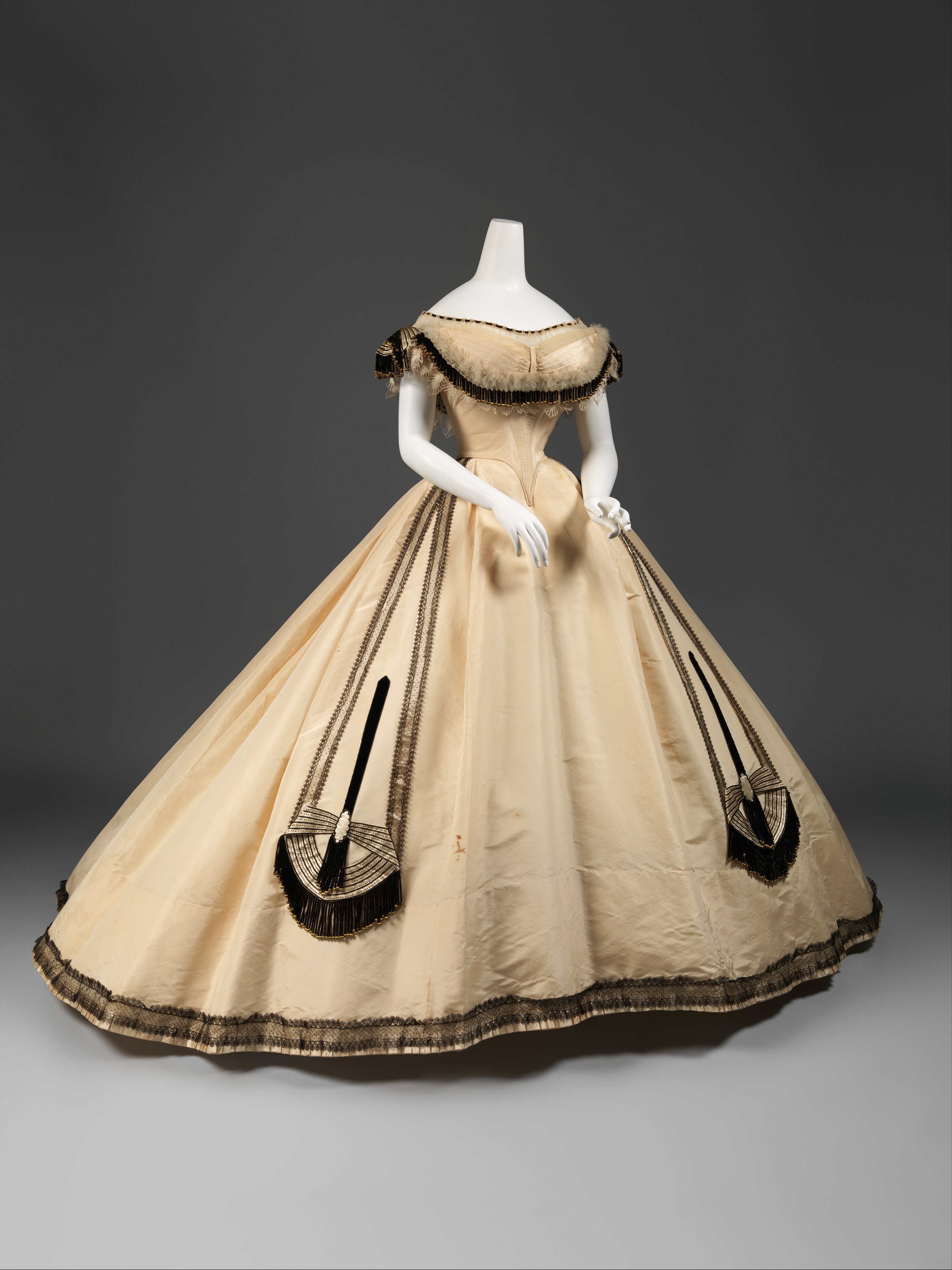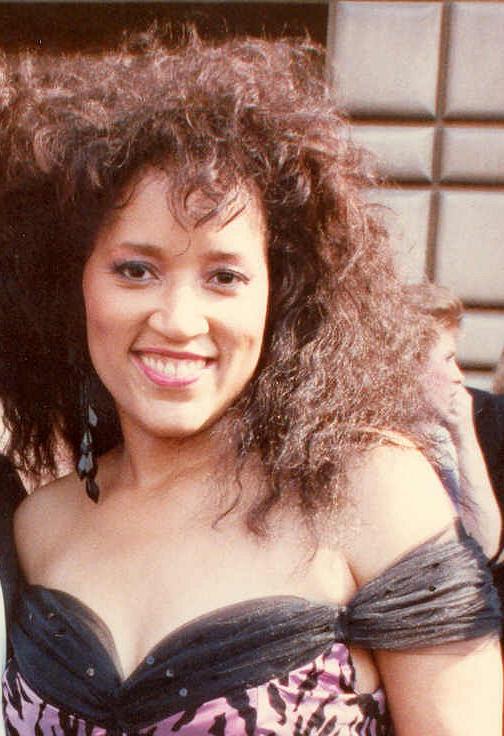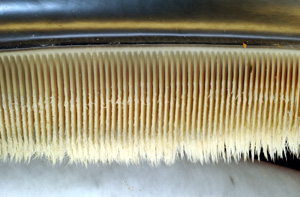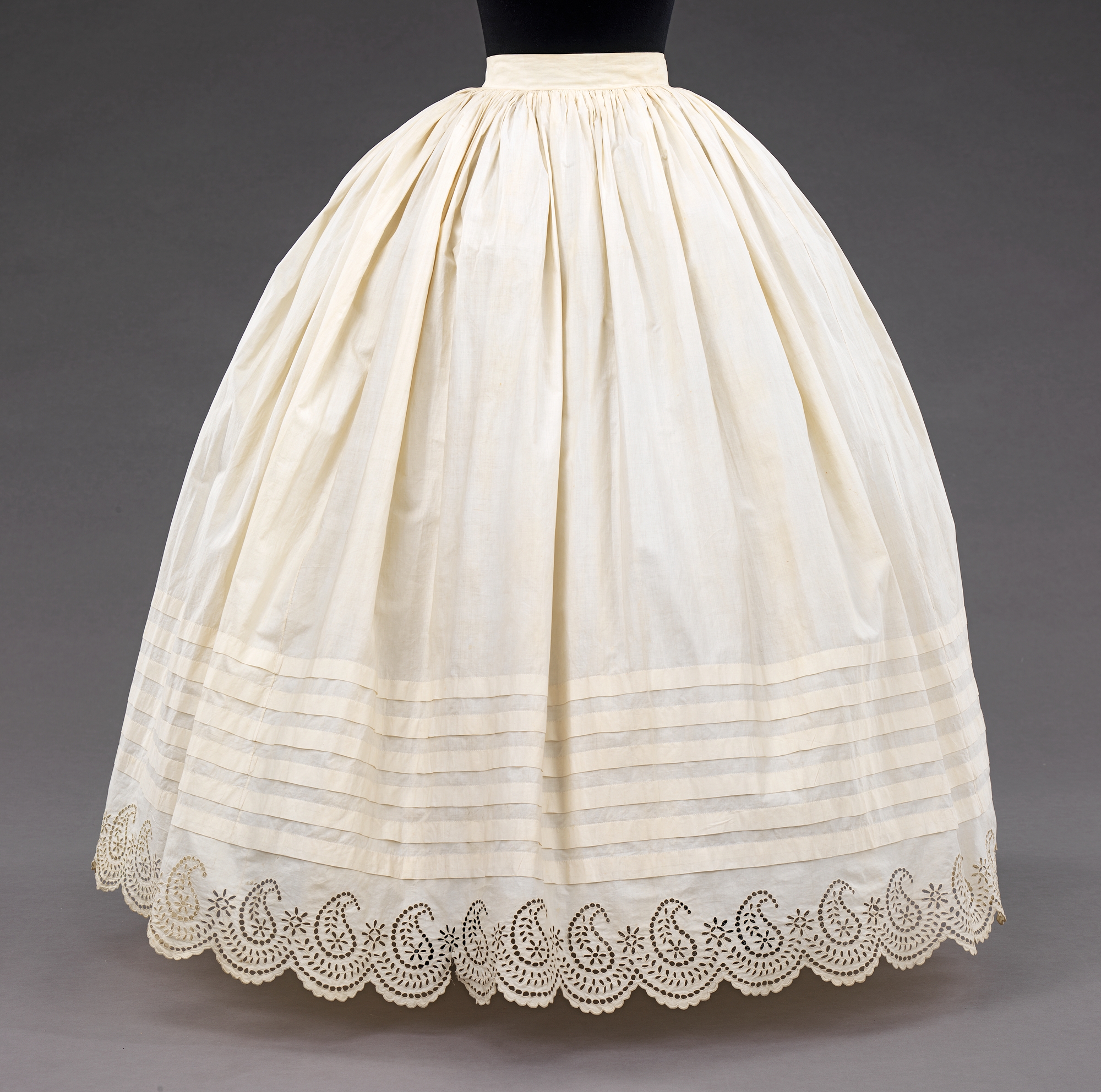|
Crinoline
A crinoline is a stiff or structured petticoat designed to hold out a skirt, popular at various times since the mid-19th century. Originally, crinoline described a stiff fabric made of horsehair ("crin") and cotton or linen which was used to make underskirts and as a dress lining. The term crin or crinoline continues to be applied to a nylon stiffening tape used for interfacing and lining hemlines in the 21st century. By the 1850s the term crinoline was more usually applied to the fashionable silhouette provided by horsehair petticoats, and to the hoop skirts that replaced them in the mid-1850s. In form and function these hoop skirts were similar to the 16th- and 17th-century farthingale and to 18th-century panniers, in that they too enabled skirts to spread even wider and more fully. The steel-hooped cage crinoline, first patented in April 1856 by R.C. Milliet in Paris, and by their agent in Britain a few months later, became extremely popular. Steel cage crinolines were ... [...More Info...] [...Related Items...] OR: [Wikipedia] [Google] [Baidu] |
1850s In Western Fashion
1850s fashion in Western and Western-influenced clothing is characterized by an increase in the width of women's skirts supported by crinolines or hoops, the mass production of sewing machines, and the beginnings of dress reform. Masculine styles began to originate more in London, while female fashions originated almost exclusively in Paris. Women's fashion Gowns In the 1850s, the domed skirts of the 1840s continued to expand. Skirts were made fuller by means of flounces (deep ruffles), usually in tiers of three, gathered tightly at the top and stiffened with horsehair braid at the bottom. Early in the decade, bodices of morning dresses featured panels over the shoulder that were gathered into a blunt point at the slightly dropped waist. These bodices generally fastened in back by means of hooks and eyes, but a new fashion for a acketbodice appeared as well, buttoned in front and worn over a chemisette. Wider bell-shaped or ''pagoda'' sleeves were worn over false un ... [...More Info...] [...Related Items...] OR: [Wikipedia] [Google] [Baidu] |
Bustle
A bustle is a padded undergarment or wire frame used to add fullness, or support the drapery, at the back of women's dresses in the mid-to-late 19th century. Bustles are worn under the skirt in the back, just below the waist, to keep the skirt from dragging. Heavy fabric tended to pull the back of a skirt down and flatten it. As a result a woman's petticoated skirt would lose its shape during everyday wear (from merely sitting down or moving about). Origin Women throughout history have used various methods to shape their skirts to accentuate the back of the hips. Padded cushions, historically called "bum rolls", "bearers", and "cork rumps", were among the many methods popular in Europe. They enjoyed sporadic popularity starting in the 16th century and were especially popular in France in the late 18th century. The crinoline was a type of integrated padded petticoat that developed from this technology. The more elaborate and specialized bustle eventually replaced the crinoli ... [...More Info...] [...Related Items...] OR: [Wikipedia] [Google] [Baidu] |
Miniskirt
A miniskirt (or mini-skirt, mini skirt, or mini) is a skirt with its hemline well above the knees, generally at mid-thigh level, normally no longer than below the buttocks; and a dress with such a hemline is called a minidress or a miniskirt dress. A micro-miniskirt or microskirt is a miniskirt with its hemline at the upper thigh, at or just below crotch or underwear level. Short skirts existed for a long time before they made it into mainstream fashion, though they were generally not called "mini" until they became a fashion trend in the 1960s. Instances of clothing resembling miniskirts have been identified by archaeologists and historians as far back as –1370 BC. In the early 20th century, the dancer Josephine Baker's banana skirt that she wore for her mid-1920s performances in the Folies Bergère was subsequently likened to a miniskirt. Extremely short skirts became a staple of 20th-century science fiction, particularly in 1940s pulp artwork, such as that by Earle K. B ... [...More Info...] [...Related Items...] OR: [Wikipedia] [Google] [Baidu] |
Hoop Skirt
A hoop skirt or hoopskirt is a women's undergarment worn in various periods to hold the skirt extended into a fashionable shape. It originated as a modest-sized mechanism for holding long skirts away from one's legs, to stay cooler in hot climates and to keep from tripping on the skirt during various activities. Small hoops might be worn by farmers and while working in the garden. Hoops were then adopted as a fashion item, and the size and scale of the hoops grew in grandeur, especially during the mid-nineteenth century transition from the 1850s to the 1860s.Fogg, Marnie: ''Fashion: The Whole Story'', 2013, Prestel, New York, New York, As the society of consumerism evolved, the roles of men and women changed and so did their dress. In the mid-19th century, the fashionable silhouette was a small waist with large, dome-shaped skirts. More and more petticoats were added to make the skirts appear even larger. When the circular crinoline came out in 1856, it was a revelation not ... [...More Info...] [...Related Items...] OR: [Wikipedia] [Google] [Baidu] |
Vivienne Westwood
Dame Vivienne Isabel Westwood (; 8 April 1941 – 29 December 2022) was an English fashion designer and businesswoman, largely responsible for bringing modern punk and new wave fashions into the mainstream. In 2022, ''Sky Arts'' ranked her the 4th most influential artist in Britain of the last 50 years. Westwood came to public notice when she made clothes for the boutique that she and Malcolm McLaren ran on King's Road, which became known as Sex. Their ability to synchronise clothing and music shaped the 1970s UK punk scene, which included McLaren's band, the Sex Pistols. She viewed punk as a way of "seeing if one could put a spoke in the system". Westwood opened four shops in London and eventually expanded throughout Britain and the world, selling a varied range of merchandise, some of which promoted her political causes such as the Campaign for Nuclear Disarmament, climate change and civil rights groups. Life and career Early years Westwood was born in Hollingworth, Chesh ... [...More Info...] [...Related Items...] OR: [Wikipedia] [Google] [Baidu] |
Ball Gown
A ball gown, ballgown or gown is a type of evening gown worn to a ball or a formal event. Most versions are cut off the shoulder with a low décolletage, exposed arms, and long bouffant styled skirts. Such gowns are typically worn with opera-length white gloves, vintage jewelry or couture, and a stole (a formal shawl in expensive fabric), cape, or cloak in lieu of a coat. Where "state decorations" are to be worn, they are on a bow pinned to the chest, and married women wear a tiara if they have one. Although synthetic fabrics are now sometimes used, the most common fabrics are satin, silk, taffeta and velvet with trimmings of lace, pearls, sequins, embroidery, ruffles, ribbons, rosettes and ruching. History 1850s In previous years, the same type of dress might have been called an evening dress, having very similar features; low-cut neckline, a tight bodice, a large skirt and (sometimes) bare arms. The ball gown at this time had similar features, a full skirt supported by a p ... [...More Info...] [...Related Items...] OR: [Wikipedia] [Google] [Baidu] |
1980s In Fashion
Fashion of the 1980s was characterized by a rejection of psychedelic colored, ornate fashions of the 1970s. Punk fashion began as a reaction against both the hippie movement of the past decades and the materialist values of the current decade. The first half of the decade was relatively tame in comparison to the second half, which was when apparel became very bright and vivid in appearance. One of the features of fashion in the second half of the 1980s was the interest in alternative forms. In the 1980s, alternative trends became widespread. This phenomenon has been associated with such phenomena as street style, punk and post-punk. During the 1980s, shoulder pads, which also inspired " power dressing," became common among the growing number of career-driven women. Hair in the 1980s was typically big, curly, bouffant and heavily styled. Television shows such as ''Dynasty'' helped popularize the high volume bouffant and glamorous image associated with it. Women in the 19 ... [...More Info...] [...Related Items...] OR: [Wikipedia] [Google] [Baidu] |
Pannier (clothing)
Panniers or side hoops are women's undergarments worn in the 17th and 18th centuries to extend the width of the skirts at the side while leaving the front and back relatively flat. This provided a panel where woven patterns, elaborate decorations and rich embroidery could be displayed and fully appreciated. History The style originated in Spanish court dress of the 17th century, familiar in portraits by Velázquez. The fashion spread to France and from there to the rest of Europe after c. 1718–1719, when some Spanish dresses had been displayed in Paris. It is also suggested that the pannier originated in Germany or England, having been around since 1710 in England, and appearing in the French court in the last years of Louis XIV’s reign. The earlier form of the pannier took the shape similar to a 19th-century crinoline. They were wide and domed in circumference. As they developed, they differed from earlier equivalents such as its predecessor, the farthingale of the la ... [...More Info...] [...Related Items...] OR: [Wikipedia] [Google] [Baidu] |
Whalebone
Baleen is a filter-feeding system inside the mouths of baleen whales. To use baleen, the whale first opens its mouth underwater to take in water. The whale then pushes the water out, and animals such as krill are filtered by the baleen and remain as a food source for the whale. Baleen is similar to bristles and consists of keratin, the same substance found in human fingernails, skin and hair. Baleen is a skin derivative. Some whales, such as the bowhead whale, have baleen of differing lengths. Other whales, such as the gray whale, only use one side of their baleen. These baleen bristles are arranged in plates across the upper jaw of whales. Depending on the species, a baleen plate can be long, and weigh up to . Its hairy fringes are called baleen hair or whalebone hair. They are also called baleen bristles, which in sei whales are highly calcified, with calcification functioning to increase their stiffness. Baleen plates are broader at the gumline (base). The plates have be ... [...More Info...] [...Related Items...] OR: [Wikipedia] [Google] [Baidu] |
Pannier (clothing)
Panniers or side hoops are women's undergarments worn in the 17th and 18th centuries to extend the width of the skirts at the side while leaving the front and back relatively flat. This provided a panel where woven patterns, elaborate decorations and rich embroidery could be displayed and fully appreciated. History The style originated in Spanish court dress of the 17th century, familiar in portraits by Velázquez. The fashion spread to France and from there to the rest of Europe after c. 1718–1719, when some Spanish dresses had been displayed in Paris. It is also suggested that the pannier originated in Germany or England, having been around since 1710 in England, and appearing in the French court in the last years of Louis XIV’s reign. The earlier form of the pannier took the shape similar to a 19th-century crinoline. They were wide and domed in circumference. As they developed, they differed from earlier equivalents such as its predecessor, the farthingale of the la ... [...More Info...] [...Related Items...] OR: [Wikipedia] [Google] [Baidu] |
Farthingale
A farthingale is one of several structures used under Western European women's clothing - especially in the 16th and 17th centuries - to support the skirts in the desired shape and to enlarge the lower half of the body. The fashion originated in Spain in the fifteenth century. Farthingales served important social and cultural functions for women in Renaissance Europe as they expressed, primarily when worn by court women, high social position and wealth. Spanish farthingale The Spanish ''verdugado'', from which "farthingale" derives, was a hoop skirt originally stiffened with Esparto, esparto grass; later designs in the temperate climate zone were stiffened with osiers (withy, willow withies), rope, or (from about 1580) whalebone. The name ''verdugado'' comes from the Spanish language, Spanish ''verdugo'' ("green wood", or the more modern meaning of "executioner"). The earliest sources indicate that Joan of Portugal started to use verdugados with hoops in Spain. Joan had pro ... [...More Info...] [...Related Items...] OR: [Wikipedia] [Google] [Baidu] |
Petticoat
A petticoat or underskirt is an article of clothing, a type of undergarment worn under a skirt or a dress. Its precise meaning varies over centuries and between countries. According to the ''Oxford English Dictionary'', in current British English, a petticoat is "a light loose undergarment ... hanging from the shoulders or waist". In modern American usage, "petticoat" refers only to a garment hanging from the waist. They are most often made of cotton, silk or tulle. Without petticoats, skirts of the 1850s would not have the volume they were known for. In historical contexts (16th to mid-19th centuries), ''petticoat'' refers to any separate skirt worn with a gown, bedgown, bodice or jacket; these petticoats are not, strictly speaking, underwear, as they were made to be seen. In both historical and modern contexts, ''petticoat'' refers to skirt-like undergarments worn for warmth or to give the skirt or dress the desired attractive shape. Terminology Sometimes a petticoat ... [...More Info...] [...Related Items...] OR: [Wikipedia] [Google] [Baidu] |









